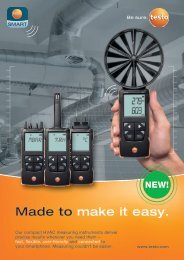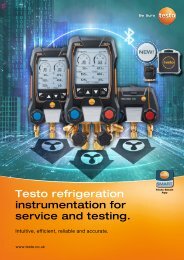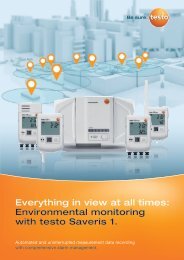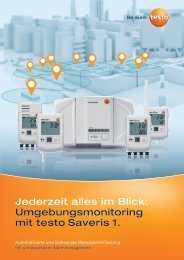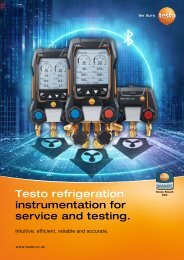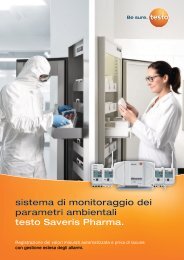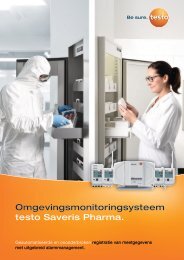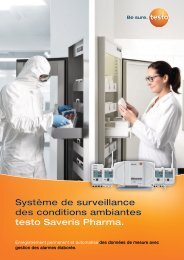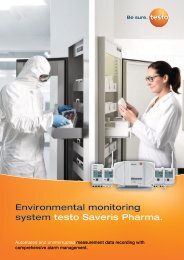Testo UK - Thermal Imaging Brochure (Oct)
You also want an ePaper? Increase the reach of your titles
YUMPU automatically turns print PDFs into web optimized ePapers that Google loves.
testo thermography<br />
<strong>Testo</strong> thermal imaging cameras<br />
for many applications.<br />
<strong>Thermal</strong> imaging cameras are highly versatile and can be deployed wherever there is a need to<br />
visualise temperature, making them a measuring instrument for many varied applications.<br />
3. Electrical testing<br />
<strong>Testo</strong> thermal imaging cameras allow a safe and effective<br />
evaluation of the heat status of low, medium, and high<br />
voltage electrical systems. <strong>Thermal</strong> imaging can lead to<br />
early diagnosis and recognition of defective components<br />
and connections, so that the required preventative<br />
steps can be taken. This minimises the potential risk of<br />
overheating and subsequent fires that can be initiated, and<br />
also avoids costly production downtime through<br />
preventative maintenance.<br />
1. Detecting structural defects and ensuring<br />
construction quality<br />
Inspection with a <strong>Testo</strong> thermal imager is a fast and<br />
efficient method of detecting possible structural defects.<br />
In addition, <strong>Testo</strong> thermal imagers are suitable as proof<br />
of the quality and the correct implementation of structural<br />
renovation measures. Heat loss, moisture and lack of airtightness<br />
in a building are visible in a thermal image. Faulty<br />
thermal insulation and structural damage are also detected<br />
– without contact.<br />
2. Carrying out detailed energy consultancy<br />
In building thermography, infrared technology is ideally<br />
suited for the fast and effective analysis of energy losses in<br />
the heating or air conditioning of buildings. Thanks to their<br />
high temperature resolution, <strong>Testo</strong> thermal imagers provide<br />
detailed images of inadequate insulation and thermal<br />
bridges. They are ideal for the recording and documentation<br />
of energy losses on outer windows and doors, roller blind<br />
casings, radiator niches, in roof structures or the entire<br />
building shell. <strong>Testo</strong> thermal imagers are the perfect tool for<br />
comprehensive diagnosis and maintenance when providing<br />
energy consultation services.<br />
4. Monitoring and checking solar energy systems<br />
There are two main reasons for inspecting solar energy<br />
systems: safety and performance monitoring. Solar energy<br />
systems achieve their top performance in full sunshine.<br />
<strong>Testo</strong> thermal imagers can be used to monitor photovoltaic<br />
systems of all sizes in a way that is wide-ranging, contactfree<br />
and exceptionally efficient. Malfunctions are detected,<br />
the proper functioning of all components is ensured and the<br />
greatest possible efficiency is thus achieved. The option<br />
of inputting solar radiation intensity, the key measurement<br />
parameter, offers extra reliability: the value entered is<br />
stored with the thermal image and is subsequently available<br />
for image analysis.<br />
5. Mechanical testing :<br />
With many mechanical systems a high level of heat<br />
emissions could be indicative of problems such as frictional<br />
wear or lack of lubrication. With the ability to work across a<br />
wide temperature range testo thermal imaging cameras can<br />
offer a fast non-contact route to diagnosis of such issues<br />
in a wide range of mechanical systems such as motors,<br />
gearboxes, bearings, conveyors, heat-sealing, and general<br />
process machinery. The ability to take images over a time<br />
period allows engineers to determine general wear cycles<br />
across operating machinery to then ensure correct<br />
preventative maintenance takes place.<br />
6<br />
7




